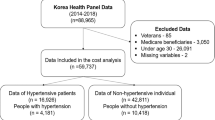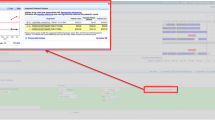Summary
Recent surveys in the U.S. have reported, for the first time, that a significant number of patients with hypertension are finding that the cost of medication and treatment in general is an obstacle to treatment. The cost of management of hypertension can be contained if: a) the diagnostic workup is kept simple (this does not include the use of routine echocardiography or 24-hour monitoring) and b) medications that are relatively inexpensive and easily titratable on one or two visits are chosen. Despite some claims to the contrary, there are relatively few instances where significant metabolic changes are noted, regardless of the medication chosen, that require repeated blood determinations or frequent office visits.
Similar content being viewed by others
References
Stason WB. Opportunities for improving the cost-effectiveness of antihypertensive treatment.Am J Med 1986;81 (Suppl 6C):45–49.
Kaplan N. Whom to treat: The dilemma of mild hypertension.Am Heart J 1981;101:867–870.
Moser, M. A decade of progress in the management of hypertension.Hypertension 1983;5:808–813.
Report of the Joint National Committee on Detection, Evaluation and Treatment of High Blood Pressure.JAMA 1977;237:255–261.
Report of the Joint National Committee on Detection, Evaluation and Treatment of High Blood Pressure.Arch Intern Med 1980;140:1280–1285.
Report of the Joint National Committee on Detection, Evaluation and Treatment of High Blood Pressure.Arch Intern Med 1984;144:1045–1057.
Report of the Joint National Committee on Detection, Evaluation and Treatment of High Blood Pressure.Arch Intern Med 1988;148:1023–1038.
Hypertension Detection and Follow-Up Program Coopera-ative Group. Five-year findings of the Hypertension Detection and Follow-up Program: 1. Reduction in mortality of persons with high blood pressure, including mild hypertension.JAMA 1979;242:2562–2577.
Kannel WB, McGee D, Gordon T. A general cardiovascular risk profile: The Framingham Study.Am J Cardiol 1976;38:46–51.
Moser M, Gifford R. Why less severe degrees of hypertension should be treated.J Hypertension 1985;3:437–447.
Perloff D, Sokolow M, Cowan R. The prognostic value of ambulatory blood pressure.JAMA 1983;249:2793–2798.
Moser M, et al. Long-term management of hypertension. Private practice experience.NY State J Med 1980;80:1102.
Zusman RM. Alternatives to traditional antihypertensive therapy [editorial].Hypertension 1986;8:837–842.
Moser M. In defense of traditional antihypertensive therapyHypertension 1988;12:324–326.
Shulman NB, Martinez B, Brogan D, Carr AA, Miles CG. Financial cost as an obstacle to hypertension therapy.Am J Public Health 1986;76:1105–1108.
Gallup G, Cotugno HE. Preferences and practices of Americans and their physicians in antihypertensive therapy.Am J Med 1986;81 (Suppl 6C):20–24.
Author information
Authors and Affiliations
Rights and permissions
About this article
Cite this article
Moser, M. The costs of treating hypertension. Cardiovasc Drug Ther 3, 743–747 (1989). https://doi.org/10.1007/BF01857624
Issue Date:
DOI: https://doi.org/10.1007/BF01857624




